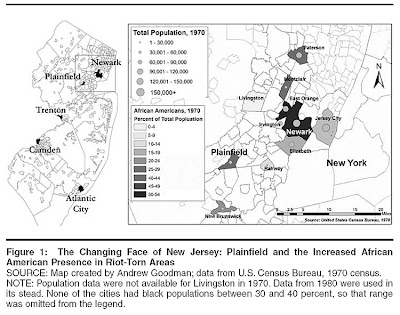Not being a native Jerseyan, I have been struck in my quarter-century here that the disturbances of 1967 seem to call to mind only TWO towns in New Jersey -- Newark and Plainfield.
Taking that at face value as all there is to be said would be a mistake.
Many other towns in New Jersey also had disturbances that summer -- Rahway, Livingston, Elizabeth, New Brunswick, East Orange, Paterson, Englewood, Irvington, Jersey City, and Montclair. Yes, Montclair.
I remember sitting in a bar with reporters from the Reading Eagle and watching television news coverage of a riot in a New Jersey city.
That would be Montclair, New Jersey.
On this weekend when those events are remembered and much written about in the newspapers, you will search in vain to find a mention of these other towns.
It has always been a mystery to me why they are no longer mentioned when talk turns to the 'riots' of 1967. Why not?
Some has to do with how the situations in those various towns worked themselves out, I'm sure. In Elizabeth, for instance, Imam Heshaam Jaaber is credited with avoiding -- through dint of his personality and perspicaciousness -- riotous situations such as Newark's.
The history of ALL the disturbances in New Jersey in that long-ago summer has yet to be written. I hope it will be.
In the meantime, we have a start with a brief history, "Plainfield Burning: Black Rebellion in the Suburban North", by Thomas Shugrue and Andrew Goodman, published in the May 2007 issue of the Journal of Urban History.
The authors write --
Nearly half of the uprisings during the “long hot summer” of 1967 occurred in [northern] small towns and suburbs, though their history is virtually unknown. This article argues that the civil disorders of the 1960s were the consequence of a long, unresolved history of racial tension in the suburbs, the failure of local government to address the grievances of African Americans, and the growing currency of a militant rhetoric of self-determination and rebellion among black suburban youth.
It is available online, for a fee, and also at the Plainfield Public Library.
Those interested will find it a useful preliminary investigation of a pivotal chapter in Plainfield history.
The epigram for the piece is prophetic --
Each summer is getting more dangerous than the past one. Each summer meansThe quote is from a story that ran in the newspapers THE DAY BEFORE the events in Plainfield.
more young people in the street, more young people unemployed, and more
broken promises. But the problem is that if anything’s going to blow, there’s a
good chance it’s likely to happen where it’s least expected.
—Dr. Paul N. Ylvisaker, commissioner, New Jersey Department of Community Affairs
Resources:
-- Dan Damon
View today's CLIPS here. Not getting your own CLIPS email daily? Click here to subscribe.
ARCHIVED POSTS OF PLAINFIELD TODAY FROM 11/03/2005 THROUGH 12/31/2006 ARE AT
http://plainfieldtoday.blogspot.com/
http://plainfieldtoday.blogspot.com/







2 comments:
Dan, I grew up in Irvington and I do not remember that there was any riot or disturbance during the summer of 1967. Springfield Avenue connects Newark to Irvington and there was some problems along there but not in Irvington.
Dan replies: Here's where I got the info; they refer to the original Kerner Report. --
"During July—the same month as the Newark and Detroit uprisings—unrest shattered the peace of places as diverse as Wyandanch and Nyack, New York; Massillon and Sandusky, Ohio; and several small cities and suburbs in New Jersey, including Plainfield, Rahway, Livingston, Elizabeth, East Orange, Paterson,
Englewood, Irvington, Jersey City, and Montclair³." -- Shugrue & Goodman, third page of article.
Footnote 3. For a list of places of riot outbreaks in 1967, see Report-NACCD [The Kerner Commission Report], 323-24.
The Shugrue & Goodman paper or report is a poorly researched revisionist piece of crap masquerading as some sort of "final word" on what happened in Plainfield in July 1967.
Post a Comment